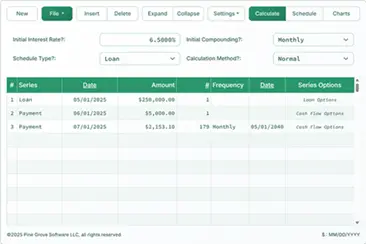How to Calculate the Future Value of an
Investment with Cash Flows
To set your preferred currency and date format, click the “$ : MM/DD/YYYY” link in the lower right corner of any calculator.
A Step-by-Step Tutorial
Tutorial 2
This tutorial shows you how to calculate the future value of a series of regular investments.
Before using this tutorial, review the more detailed first tutorial to understand the Ultimate Financial Calculator (UFC) and its core settings and concepts.
In general, investment and savings cash flows fall into one of four categories. Each has the following characteristics:
- A series of deposits followed by one withdrawal. A defined savings plan with a specific goal usually follows this pattern (this tutorial).
- One initial deposit followed by a series of withdrawals. A retirement annuity is typically structured this way.
- Multiple deposits and multiple withdrawals. This is common for a college savings or retirement plan.
- A fully irregular pattern with multiple deposits and intermittent withdrawals. Stock, bond, or mutual fund investing often follows this pattern.
The Ultimate Financial Calculator can handle all of these cash flow types, including variations.
To create a savings plan schedule with an unknown withdrawal amount, based on 10 years of quarterly deposits, follow these steps:
- Set Schedule Type to Savings.
- Or click the button to clear all previous entries.
- Set the initial values for the investment cash flow in the header section.
- You may change both the interest rate and compounding method later in the schedule (see Tutorial 4).
- For Initial Interest Rate, enter 4.5 (this means a 4.5% nominal annual rate).
- Set Initial Compounding to Daily.
- For Calculation Method, select Normal.
- Click the first row of the cash flow grid.
- Set Series to Deposit.
- Set the Date to 04/01/2016 (MM/DD/YYYY or per your chosen date format).
- Set the Amount to 350.00.
- Set # Periods to 40.
- Set Frequency to Quarterly.
- Create a Withdrawal series in the second row to calculate the future value of the investment.
- This tells the calculator to compute the final withdrawal amount.
- You may enter a withdrawal date that is later than the last deposit date, if the withdrawal occurs after the investment period ends.
- Click the second grid row. For Series, select Withdrawal.
- The Date will already be set to 04/01/2026.
- Set the Amount to Unknown by typing U. See Fig. 1.
- Set # Periods to 1.
- The setup is complete. You are now ready to calculate the unknown value.
- Your screen should appear similar to the following:

- Calculate — Click the button at the top of the calculator.
- The word Unknown will be replaced with the future value as of 04/01/2026. If all default settings are used and the example is followed exactly, the result will be $17,843.48. See Fig. 2.
- After making 40 quarterly deposits of $350.00 over 10 years, the depositor will have $17,843.48 available for withdrawal. This assumes a 4.5% nominal annual interest rate, daily compounding, the Normal compute method, and a 360-day year.

- Click the button to view the investment cash flow schedule.
- Click the button to view three automatically generated charts that show your savings plan. No additional setup is required.
Variations: If you know the regular deposit amount, the withdrawal amount, and the date when funds will be available, you may set the Initial Interest Rate to Unknown. The calculator will then compute the nominal annual interest rate required.
You may also solve for # Periods. Set # Periods in the first row to Unknown to calculate how many periods are needed to reach your investment goal.
Important: If the withdrawal date is earlier than the final deposit date (based on the number of periods needed), the calculator will still allow the withdrawal. However, the balance will go negative. In this case, the ongoing deposits are repaying a loan until the balance reaches zero.
Note: You can apply techniques from other tutorials here as well. You may adjust deposit amounts, interest rate assumptions, deposit dates, or account for skipped deposits and inflation. See .
There are many financial calculators available on this site. If the Ultimate Financial Calculator does not meet your needs, or if you have a question about setting up a mortgage, loan, or investment calculation, please post a question in the comment section at the bottom of any calculator page.
Back to the Ultimate Financial Calculator.
